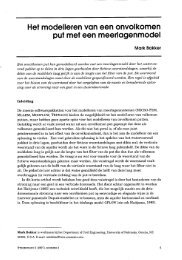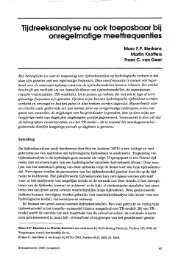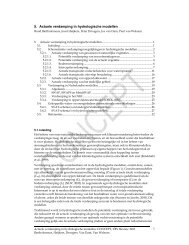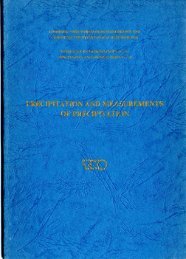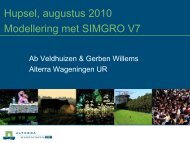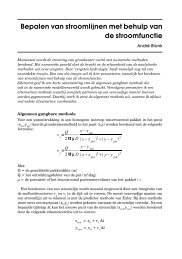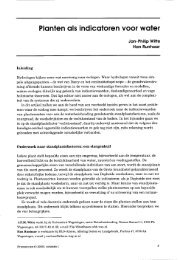Hydro-ecological relations in the Delta Waters
Hydro-ecological relations in the Delta Waters
Hydro-ecological relations in the Delta Waters
You also want an ePaper? Increase the reach of your titles
YUMPU automatically turns print PDFs into web optimized ePapers that Google loves.
this volume or <strong>in</strong> Duutsaa, et aL, 1982. The situation is descriBed up<br />
to 1984 s<strong>in</strong>ce <strong>the</strong> data on birds presented <strong>in</strong> thia paper are restricted<br />
to <strong>the</strong> period 1976-1984.<br />
The major physical and chemical characteristics of <strong>the</strong> afferent bas<strong>in</strong>s<br />
are given <strong>in</strong> Table 1. For each OS <strong>the</strong> tidal areas, <strong>the</strong> surface of<br />
salt marshes, tidal flats, tidal waters (<strong>the</strong> area permanently covered<br />
by water) and adjacent wetlands (creeks, "<strong>in</strong>lagen" and grasslands which<br />
are used by birds ei<strong>the</strong>r as rest<strong>in</strong>g or as additivnal feediqg sites) is<br />
given. For tbe lakes <strong>the</strong> surface of deep water ( > 1.5 m), @hallow<br />
wager ( 1.5 m) and sbwes is given. Shores are <strong>the</strong> very shallow areas<br />
( F 0.2 m) of <strong>the</strong> lake of <strong>the</strong> majority of <strong>the</strong> areas perraanently exp~sed<br />
after <strong>the</strong> fomatlon of <strong>the</strong> lake and now used by weterbirds<br />
Kagrieultural land, nature reserve etc.) as well as <strong>the</strong> adjacent<br />
wetlands.<br />
The Voordelta is that part of <strong>the</strong> North Sea just off <strong>the</strong> <strong>Delta</strong> area. It<br />
consists bf a system of chwnels and shallow areas. Sal<strong>in</strong>try atrd<br />
turbidity are high. The sandy beaches are subject to hem wave action<br />
and su£fer from a very high ~ecreation pressure. More details of thia<br />
area and <strong>the</strong> changes occurr<strong>in</strong>g here ate described by Mulder, 1989. The<br />
Westerschelde is <strong>the</strong> only rema*n<strong>in</strong>g true estuary <strong>in</strong> <strong>the</strong> <strong>Delta</strong>. The<br />
freshwater <strong>in</strong>put frqm <strong>the</strong> river Schelde is small (on average 100<br />
m3/sec), hence <strong>the</strong> braokish part is limited to <strong>the</strong> area beMwn<br />
Ancwerpen and Hansweert. From <strong>the</strong> mouth tmards Antwerpen a gradient of<br />
decreas<strong>in</strong>g sal<strong>in</strong>ity, oxygen and transparency. and of <strong>in</strong>ereas<strong>in</strong>g<br />
suspended meter and nutrients is found (Humel, et al, 19881. Large<br />
mid- and sandflats occur all over <strong>the</strong> eatuary. "Bet Verdronken Land van<br />
Saeft<strong>in</strong>ghe". <strong>in</strong> <strong>the</strong> brackish part BE <strong>the</strong> estuary, i5 <strong>the</strong> largest salt<br />
marsh (8250 ha) of <strong>the</strong> whole <strong>Delta</strong> area. The esnurry is characterized<br />
by a large anthropogenic stress due to discharges of <strong>in</strong>organic and<br />
organic eontamfnants, mfnly by <strong>the</strong> river Sahel.de, but alsa from othar<br />
effluenrs slew <strong>the</strong> Westerschelde itself, and due to <strong>in</strong>tensive dredg<strong>in</strong>g<br />
activities for shipp<strong>in</strong>g. In <strong>the</strong> Oesrerschelde rhe <strong>in</strong>put Q£ fresh water<br />
is so small, that <strong>the</strong> area is better characterized as a sea arm than as<br />
an estuary. Sal<strong>in</strong>ity is high and constant; turbidity, concearrations of<br />
nutrieets and pollutants are low. Before <strong>the</strong> constructioo of <strong>the</strong>





